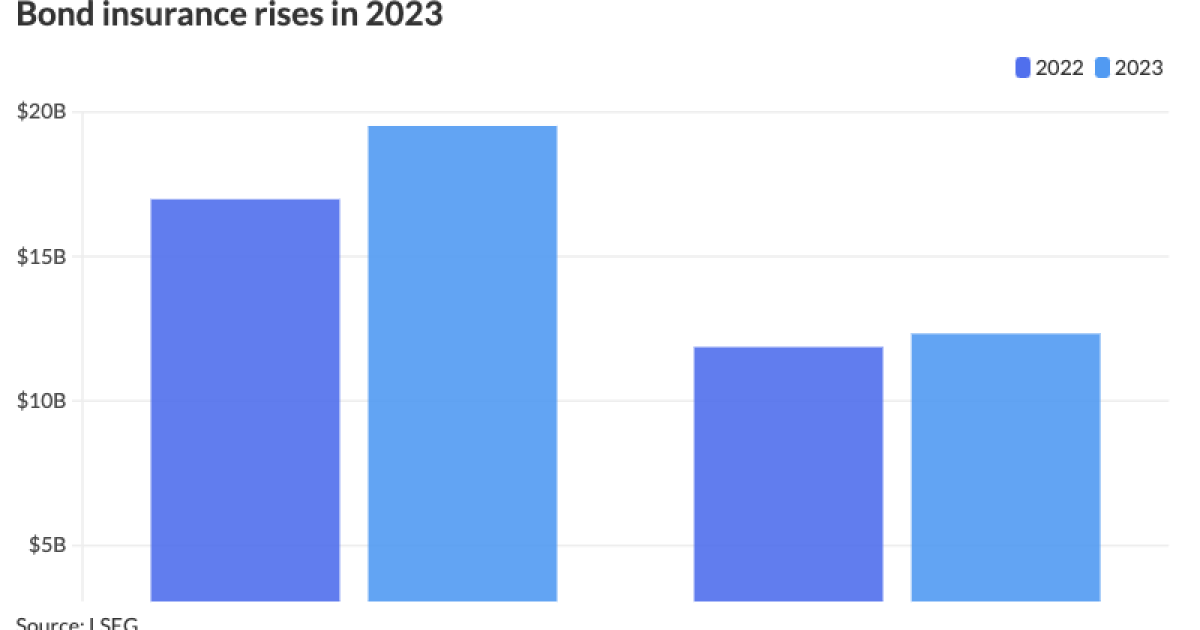Bond insurance rises, sees highest penetration since 2008
3 min read
The amount of debt wrapped by bond insurance rose 5.8% in 2023, leading to the highest market penetration rate since 2008, despite the second year of down issuance.
Demand for bond insurance has continued to grow in 2023 as market participants turned to it for investor confidence, increased market liquidity and enhanced credit ratings.
All municipal bond insurers wrapped $35.381 billion in 2023, an increase from the $33.428 billion insured in 2022, according to LSEG data.
The two main insurers, Assured Guaranty Municipal Corp. and Build America Mutual, accounted for $31.845 billion of deals in 2023 compared to $28.847 billion in 2022.
The LSEG data considers other types of guarantees such as state-backed funds.
The industry par amount was achieved in 1,398 deals versus 1,425 deals in 2022.
Assured Guaranty accounted for a total of $19.516 billion in 645 deals, accounting for 55.2% of the market share, up from the $16.980 billion in 648 deals for a 50.8% market share in 2022, according to LSEG data.
Build America Mutual insured $12.330 billion in 752 deals, or 34.9% of the market share. That compares to $11.867 billion, or a 35.5% market share, in 775 deals in 2022, according to LSEG data.
Insured tax-exempt issues rose 17.2% to $30.867 billion while taxables dropped 76.9% to $892.1 million. New-money issuance with insurance rose to $28.061 billion, a 8.2% gain, while refundings decreased to $3.327 billion, or 23.8% less.
Both insurers saw year-over-year growth. Bond insurance for Assured and BAM rose 14.9% and 3.9%, respectively.
For Assured, the firm’s increase in bond insurance year-over-year was helped by several large deals — $1.1 billion of insurance on Dormitory Authority of the State of New York bonds, $800 million on
Furthermore, the firm insured 37 deals with at least a $100 million par amount for a total par of $10.4 billion, signaling “strong institutional demand for our product,” he said.
“We believe this heightened demand has proven our product’s value across a wide range of transaction sectors, rating levels and deal sizes,” he said.
And BAM’s “new-issue par grew even as the market contracted in 2023, supported by strong demand from institutional investors and growing interest from separately managed accounts and other buyers who use insurance as a tool to improve their portfolios’ liquidity and ratings stability,” said Mike Stanton, head of strategy and communications at BAM.
BAM’s activity was “widely distributed geographically and across sectors, with insured transactions from 47 states, including 17 deals with par above $100 million, and more than 50 with par above $50 million,” he said.
Notable transactions “included $393 million across two
The rise in bond insurance in 2023, which the fourth quarter helped buoy to a year-over-year increase compared to the
“Investors have been more sensitive to the risk of unexpected economic developments since the onset of the pandemic in 2020, and that growth in recent years reflects both investors’ appreciation of the benefits that bond insurance provides, especially during volatile economic or uncertain market conditions, and issuers’ recognition of its cost-effectiveness and capacity to increase investor demand and market access,” Tucker said.
And with higher interest rates and wider credit spreads, he said “there is greater potential for insurance to provide financing cost savings for issuers.”
The increased utilization of bond insurance will continue, Stanton said, noting it is sustainable because insurance has become “more compelling to a wider range of buyers and issuers.”
From the investor perspective, he said bond insurance is a tool they can use to manage their overall portfolios.
“It’s rating stability and liquidity enhancement, in addition to credit enhancement,” Stanton said.
As there is more utilization of bond insurance, he said “you’re seeing more bonds traded in the marketplace, and particularly on the liquidity issue, that becomes kind of a reinforcing cycle.” “The more investors are seeing an insurance trade in the marketplace, the more comfortable they are with valuations, the more likely they are utilizing going forward,” Stanton said.
Tucker added: “The positive momentum we have seen in recent years will continue as insurance is increasingly utilized across a variety of transactions.”
Additionally, he noted, “that increased institutional demand will likely continue through the greater use of insurance on larger transactions.”







